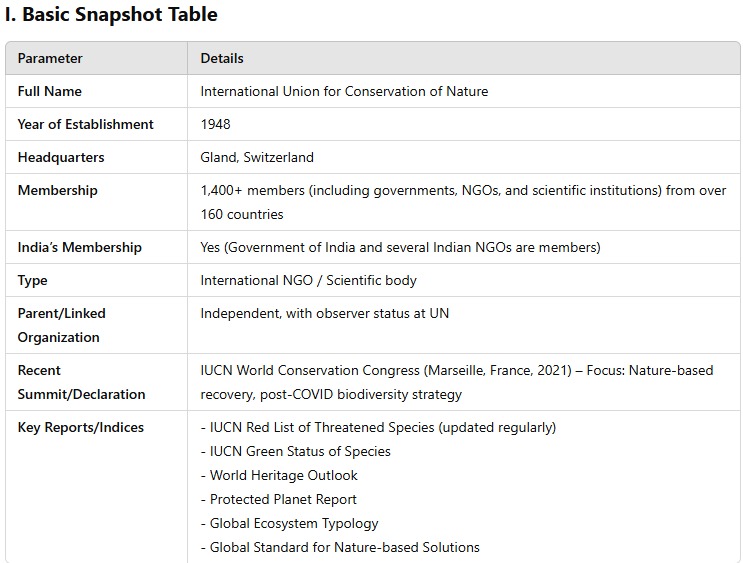4. International Union for Conservation of Nature (IUCN)


Key Objectives and Mandate
The IUCN is the world’s oldest and largest global environmental network, focused on the conservation of biodiversity and sustainable use of natural resources.
Its key roles include:
Assessing species extinction risk (via the Red List)
Supporting creation and management of protected areas
Promoting nature-based solutions to climate and development challenges
Influencing environmental governance and policy through partnerships
Organizational Structure
Membership-based body: Includes governments, NGOs, indigenous organizations, academic bodies
World Conservation Congress: Held every 4 years, sets global conservation agenda
Council and Commissions:
Species Survival Commission (SSC)
World Commission on Protected Areas (WCPA)
Commission on Environmental Law, etc.
Secretariat coordinates global operations via regional offices (Asia office in Bangkok)
India’s Role and Relevance
India is an active IUCN member, with representation from the MoEFCC, Wildlife Institute of India, and NGOs like BNHS and WWF-India
IUCN provides technical support to India in:
Red List assessment of Indian species
Protected area management (e.g., Ramsar Sites, Biosphere Reserves)
Community-based conservation programs in Himalayas and Western Ghats
India contributes to global conservation efforts under IUCN’s Green List and World Heritage Site evaluations
Key Initiatives and Developments
IUCN Red List: Over 150,000 species assessed; key tool in biodiversity tracking
IUCN Green Status of Species (launched 2021): Assesses recovery of species
Nature-based Solutions Global Standard (2020): For integrating nature in infrastructure and climate plans
Played a key role in developing the Kunming-Montreal Global Biodiversity Framework (GBF) under the CBD
Supports India’s conservation work on snow leopards, river dolphins, and Western Ghats endemic species
Additional Facts
Founded in Fontainebleau, France
IUCN was instrumental in the creation of WWF and TRAFFIC
Its Red List categories include: Extinct, Critically Endangered, Endangered, Vulnerable, etc.
IUCN Red List Index is used in SDG monitoring and IPBES reports
Observer status at the UN General Assembly
Relevance for UPSC Exam
Prelims:
Questions on Red List categories, species status, and conservation programs
Location-based questions on World Heritage Sites, Biosphere Reserves, etc.
Mains (GS3):
Role in biodiversity conservation, sustainable development, ecosystem restoration
India’s collaboration with global biodiversity organizations
Essay & Interview: Use IUCN data to support points on extinction crisis, eco-governance, and planetary health
